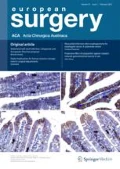Zusammenfassung
Grundlagen: Die Arbeitsgruppe für Minimal Invasive Chirurgie in Österreich (AMIC) beschloß während der 40. Jahrestagung für Chirurgie im Juni 1999 in Linz, Leitlinien für minimalinvasive chirurgische Eingriffe zu verfassen. Im folgenden Artikel wird die Laparoskopische Cholezystektomie (LCHE) abgehandelt, der wohl häufigste minimal invasive Eingriff.
Methodik: Die Arbeitsgruppenleiter der einzelnen Teilbereiche der AMIC diskutierten im Rahmen eines Meetings im Juni 1999 Zielsetzung. Inhalt und Aufbau. Anhand der vorhandenen Literatur wurden die Empfehlungen zum Thema Cholezystektomie verfaßt, welche schließlich von nationalen Experten vidiert wurden.
Ergebnisse: Die Sonographie stellt die Basis der Diagnostik dar. Die akute Cholezystitis ist keine Kontraindikation zur LCHE. Die Behandlung der Choledocholithiasis wird derzeit kontrovers beurteilt. Neben dem etablierten therapeutischen Splitting zeigt die laparoskopische Choledochussanierung exzellente Ergebnisse. Die Umstiegsrate in Österreich (4,7 %) ist so wie die Morbidität mit internationalen Zahlen vergleichbar.
Schlußfolgerungen: Die laparoskopische Cholezystektomie hat sich als Therapie der Wahl zur Behandlung des Gallensteinleidens etabliert. Bei entsprechender Sorgfalt ist es ein sicheres Verfahren mit niedriger Morbidität und Mortalität. Die LCHE eignet sich als Ausbildungsoperation.
Summary
Background: The panel of the Austrian society for minimal invasive surgery (AMIC) decided to publish guidelines for endoscopic minimal access surgical procedures. This paper concentrates on cholecystolithiasis and the laparoscopic cholecystectomy (LC).
Methods: In June 1999 a national panel of Austrian surgeons discussed the set-up for these guidelines under the auspices of the AMIC. The following recommendations concerning cholecystolithiasis and laparoscopic cholecystectomy are composed with reference to the literature and have been reviewed by national experts.
Results: Abdominal ultrasound is still the method of choice for the diagnosis of cholelithiasis. Acute cholecystitis is not a contraindication for the laparoscopic approach. The treatment of choledocholithiasis is controversially discussed. Besides the established therapeutic splitting recent papers prove excellent results for the laparoscopic treatment of common bile duct stones. The conversion rate to open cholecystectomy is 4.7 %. The Austrian results are comparable to the literature.
Conclusions: LC has become the treatment of choice for cholecystolithiasis. Taking appropriate care it can be performed safely with low morbidity and mortality. LC is suitable as an operation for beginners in laparoscopic surgery assisted by an experienced surgeon.
Literatur
Berci G, Morgenstern L: Laparoscopic management of common bile duct stones. A multi-institutional SAGES study. Surg Endosc 1994: 8: 1168–1175.
Cushieri A, Lezoche E, Morino M, Croce E, Lacy A, Toouli J, Faggioni A, Ribeiro VM, Jackimowicz J, Visa J, Hanna GB: E.A.E.S multicenter prospective randomized trial comparing two-stage vs single-stage management of patients with gallstone disease and ductal calculi. Surg Endosc 1999: 13: 952–957.
Deziel DJ, Millikan KW, Economou SG, Doolas A, Ko ST, Airan MC: Complications of Laparoscopic Cholecystectomy: A National Survey of 4,292 Hospitals and an Analyses of 77.604 Cases. Am J Surg 1993: 165: 9–14.
Fletcher DR, Hobbs MST, Tan P, Valinsky Liora J, Hockey RL, Pikora TJ, Knuiman MW, Sheiner HJ, Edis A: Complications of Cholecystektomy: Risks of the Laparoscopic Approach and Protective Effects of Operative Cholangiography. Ann Surg 1999: 229: 449–457.
Johnston S, O’Malley K, McEntee J, Grace P, Smyth E, Bouchier-Hayes D: The need to retrieve the dropped stone during laparoscopic cholecystectomy. Am J Surg 1994: 167: 608–610.
Kwon AH, Uetsuji S, Ogura T, Kamiyama Y: Spiral Computed tomography after Intravenous Infusion Cholangiography for Biliary Duct Anomalies. Am J Surg 1997: 174: 396–401.
McMahon AJ, Fullarton G, Baxter JN, O’Dywer PJ: Bile duct injury and bile leakage in laparoscopic cholecystectomy. Br J Surg 1995: 82: 307–313.
Miller BM, Kozarek RA, Ryan JA, Ball TJ, Traverso LV: Surgical versus endoscopic management of common duct stones. Ann Surg 1988: 207: 135–138.
National Institutes of Health consensus development conference statement on gallstones and laparoscopic cholecystectomy. Am J Surg 1993: 165: 390–398.
Neugebauer E, Troidl H, Kum CK, Eypasch E, Miserez M, Paul A: The E.A.E.S. Consensus Development Conferences on laparoscopic cholecystectomy, appendectomy, and hernia repair. Surg Endosc 1995: 9: 550–563.
Paul A, Millat B, Holthausen U, Sauerland S, Neugebauer E: Diagnosis and treatment of common bile duct stones (CBDS). Surg Endosc 1998: 12: 856–864.
Rhodes M, Sussman L, Cohen L, Lewis MP: Randomised trial of exploration of the common bile duct versus postoperative retrograde cholangiography for common bile duct stones. Lancet 1998: 351: 159–161.
Rieger R, Wayand W: Yield of prospective, noninvasive evaluation of the common bile duct combined with selective ERCP/sphincterotomy in 1390 consecutive laparoscopic cholecystectomy patients. Gastrointest Endosc 1995: 42: 6–12.
Schrenk P, Wayand WU: Komplikationen der operativen Laparoskopie. Österreichische Krankenhauszeitung 1994: 35: 323–325.
Stewart L, Way LW: Bile duct injuries in laparoscopic cholecystectomy. Factors that influence the results of treatment Arch Surg 1995: 123: 1123–1128.
Woods MS, Traverso LW, Kozarek RA, Donohue JH, Fletcher DR, Hunter JG, Oddsdottir M, Rossi RL, Tsao J, Windsor J: Biliary tract complications of laparoscopoic cholecystectomy are detected more frequently with routine intraoperative cholangiography. Surg Endosc 1995: 9: 1076–1080.
Author information
Authors and Affiliations
Corresponding author
Rights and permissions
About this article
Cite this article
Shamiyeh, A., Wayand, W. Laparoskopische Cholezystektomie und Choledochusrevision. Acta Chir Austriaca 32 (Suppl 6), 5–8 (2000). https://doi.org/10.1007/BF02950227
Issue Date:
DOI: https://doi.org/10.1007/BF02950227

